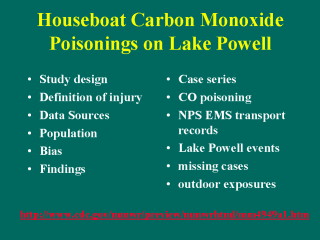| front |1 |2 |3 |4 |5 |6 |7 |8 |9 |10 |11 |12 |13 |14 |15 |16 |17 |18 |19 |20 |21 |22 |23 |24 |25 |26 |27 |28 |29 |30 |31 |32 |33 |34 |35 |36 |37 |38 |39 |40 |41 |42 |43 |44 |45 |46 |47 |48 |49 |50 |51 |review |
 |
The first paper to
examine is the MMWR paper on carbon monoxide poisonings noted at Lake Powell.
This paper attempts to identify all CO poisoning events identified from the
EMS records of the National Park Service from 1994-2000. It is thus a case
series study design. The study was initiated because of case reports of CO
poisoning death related to houseboats on the lake. The definition of injury
used was based upon information in the transport records. Cases were defined
as events with either (a) symptoms of CO poisoning and laboratory elevated
carboxyhemoglobin values or (b) exposure to exhaust and symptoms. By design,
only injuries receiving medical attention are included in this study. The study is unique in that it found several cases of outdoor exposure to CO poisoning. CO poisoning is most often found in indoor settings. The report suggests that the placement of generators on houseboats creates a poisoning hazard. It implies causality related to these generators, but the design cannot prove it in the strict methodologic sense. Potential bias in the report may be the underascertainment of CO poisoning cases. It is not clear how accurate the NPS transport records may be. Source: Houseboat associated carbon monoxide poisonings on Lake Powell. MMWR 49(49):1105-1108, December 15, 2000. |